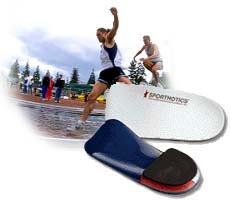|
Return to Articles Main Page
An orthotic device (orthosis) is an individually designed custom brace that changes the function of your foot.
How Do They Work?
|
An orthotic device changes the way your foot works. Your podiatrist will determine why your foot function is causing your particular symptoms. Using an orthotic may relieve the symptoms that are bothering you. Flat feet, high arches, hammertoes, neuromas, calluses, bunions and heel pain are common foot problems that may be remedied by changing your foot function. Ankle weaknesses or frequent sprains are often treated with orthotic devices. Sometimes knee and back pain which may be related to abnormal foot function can be relieved by orthotic control. One of the more common uses for foot orthotics is for postoperative control. Frequently, following surgical correction of the deformity, an orthotic device is used to reduce the possibility of its recurrence. |

|
How Much of the Time Do I Need To Wear An Orthotic?
This will vary depending on the patient’s individual needs. Orthotic control is somewhat analogous to eyeglasses. While you are wearing them, function is improved. Ideally, a person should wear the orthotic whenever he/she is on their feet. In most situations, it is advisable to wear them 75% of the time. The more they are worn, the greater the benefit.
Types of Orthotics:
There are many types of orthotics. Your doctor will decide which type is best for treating your particular problem. The material that is used will depend on the activities you are involved in while wearing them. The most corrective orthotic is made out of fiberglass and usually used for a walking gait. Activities requiring rapid direction changes (e.g. tennis, basketball, etc.), for example, may require a special cover. Various cork-like materials are better suited for runners, tennis players, etc.
The Process:
In order for the laboratory to construct your orthotic, it is necessary for your doctor to make an impression of your foot in the position we want it to function. This impression is usually made out of plaster. This impression is the most critical step in the fabrication of the orthotic device. The impressions are sent to the laboratory. They will make a positive model of your foot and will add any correction prescribed. |

|
The materials specified will then be formed to the positive model of your foot and additional corrections will be added to ensure that it balances your foot correctly. Covers, extensions and other additions are then made before the orthotic is mailed back to the office.
Summary:
Most patients experience relief within a few weeks. In some situations it may take a little longer. Your doctor will generally recommend a specific break-in schedule when your orthotic is dispensed. Most types of orthotics will work in several different types of shoes. In some cases, more than one type of orthotic is necessary in order to fit in certain shoes (e.g. dress heels). It is important to discuss, with your doctor, the types of shoes and the activities you will be participating in prior to ordering the orthotic. |

|
Return to Articles Main Page
Our Services | Referring Physicians | About Us | Frequently Asked Questions | Blog | Articles
Surgical Animations | Links | News & Press | Photo Gallery
Contact Us | Home | Legal Notice | Privacy Statement | Site Map
Copyright © Buffalo Medical Group P.C. / Podiatry Affiliates
Website Design, Maintenance and Hosting by Catalyst Marketing / Worry Free Websites |
